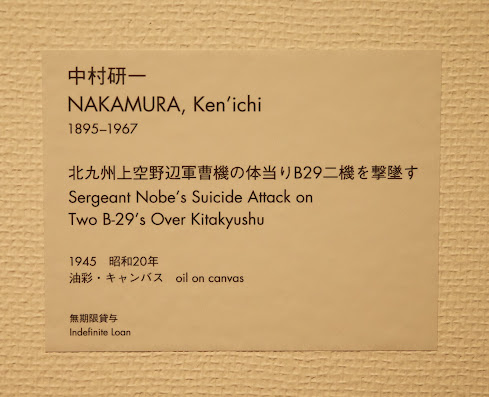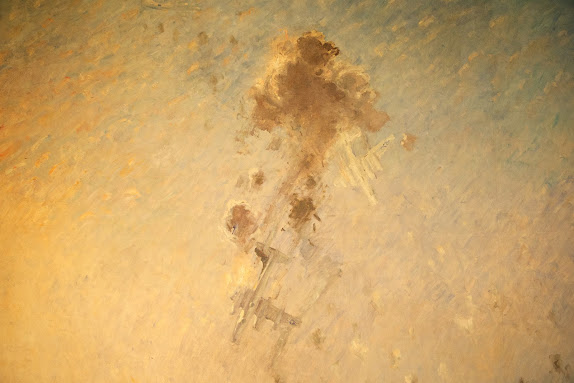I cannot remember where I saw these pictures, or which city even, was it Tokyo or Osaka, the Bridgestone Museum, or the Tokyo National museum? But anyway, and despite the poor photos made with an old i-Phone, I was certainly moved by these paintings. They provoked in me lots of feelings.
Done in a very Western style almost leads me to believe that the painter had studied abroad, USA or Europe? I remember thinking that it was an ambitious subject matter, one that depicted this iconic event in Japanese military history. As I have spent time with these paintings over the past few days they have elicited long buried memories from my childhood because photos of the war littered our house. They were scattered everywhere, in our bookshelves and desktops, coffee tables and piano tops, and making it feel, through a child's eyes, as if we lived in a black and white cemetery. Our mother, who had joined the Red Cross in Italy, hugs a soldier, one of many phantom photos of phantom people from a phantom and unreal time before my birth. Also too, there were photos of the young and handsome, the beautiful and the glamorous to a degree, and they seemed to live in the permanent glow of a party full of gaiety on the eve of World War Two.
But this painting as the title states is about a crash taking place at high altitude over Japan. One of the planes, the B-29-15 BW "Calamity Jane" was assigned to to the 20th Air Force, 468th Bombardment Group at Pengshan Airfield in China. It took off on the 20th of August 1944 piloted by Captain Cornell Stauffer on a bombing run against the Yawata Steel Works on Kyūshu island in Japan. Over the target this bomber was flying no. 4 position of a four bomber diamond formation. On the bomb run while releasing their bombs, a Japanese fighter Ki-45 Nick piloted by Sgt Shigeo Nobe rammed the lead bomber B-29 "Gertrude C" 42-6334 head on. A piece of the wreckage struck the the tail stabiliser of "Calamity Jane" in fourth position, shearing it off and causing the bomber to enter a spin and crash. Nobe's attack was the first deliberate ramming of B-29's over Japan. "Gertrude C" was obviously destroyed immediately by the fighter plane.
Four of the crew on "Calamity Jane" who survived had bailed out from the nose wheel door, the rest of the crew and pilot presumed dead. Out of the eleven crew, four survived and were captured, then interned at the Omori POW Camp near Tokyo. They were liberated after the surrender. Then Nakamura painted this epic air battle in 1945 barely one year later.
Most of us now forget this generation of heroes who climbed aboard these bombers. Indeed those lost in WW2 from all countries everywhere, both 'victors' and vanquished, perished alongside civilians, refugees, all the animals, large and small, horses by the millions, the pets, all the cats and dogs, but the homes too, and the churches and the farms alike, the artworks, along with everyone's personals. In war, no one wins despite what your leaders tell you.
Both Germany and Japan quickly became allies after all that! Of course they should be allies, but why all the destructive fuss in the first place?.... a reasonable person queries.
I have been to Normandy a few times over the years, arriving at Dieppe from Newhaven in the UK or vice-versa. I loved taking the boat back and forth across the Channel between these two great nations, themselves at war with one another for centuries. My regret is not finding my way to the headstone of my Uncle Angus MacDonell who was a B-17 pilot and flew several raids in Germany before perishing over the sea. They never found the bodies of the crew nor the plane. They were listed like so many in the war as KIA (killed in action). But apparently, our uncle and the crew had reached the sea only to then disappear. How? Where? our grandmother and mother would ask themselves relentlessly thereafter.
Most of these B-17's on bombing runs were shot down and crashed in Germany after being pummelled by fighters. The attrition rate for these raids from Britain into Germany was about about 40%. These pilots knew it but flew anyway out of duty, and hoping to be an exception to this statistic.
I think I never made attempt to locate his headstone because I had forgotten that he was lost over the Channel during the war. Wrapped up in my life I had forgotten this "Great Generation" as they are called and remembered, still venerated by the last veterans and their families. But like me, most Americans don't remember them. And this means that we will certainly still again go to war for small reasons, or none at all.
But, I have promised myself that the next time I get over to Normandy I will find this lost uncle's headstone. Like for so many other families in that time his death shattered our family. The wounds lingered on, infecting everyone, and disabling my mother's sanity.
our uncle, Captain Angus MacDonell in his B-17






No comments:
Post a Comment